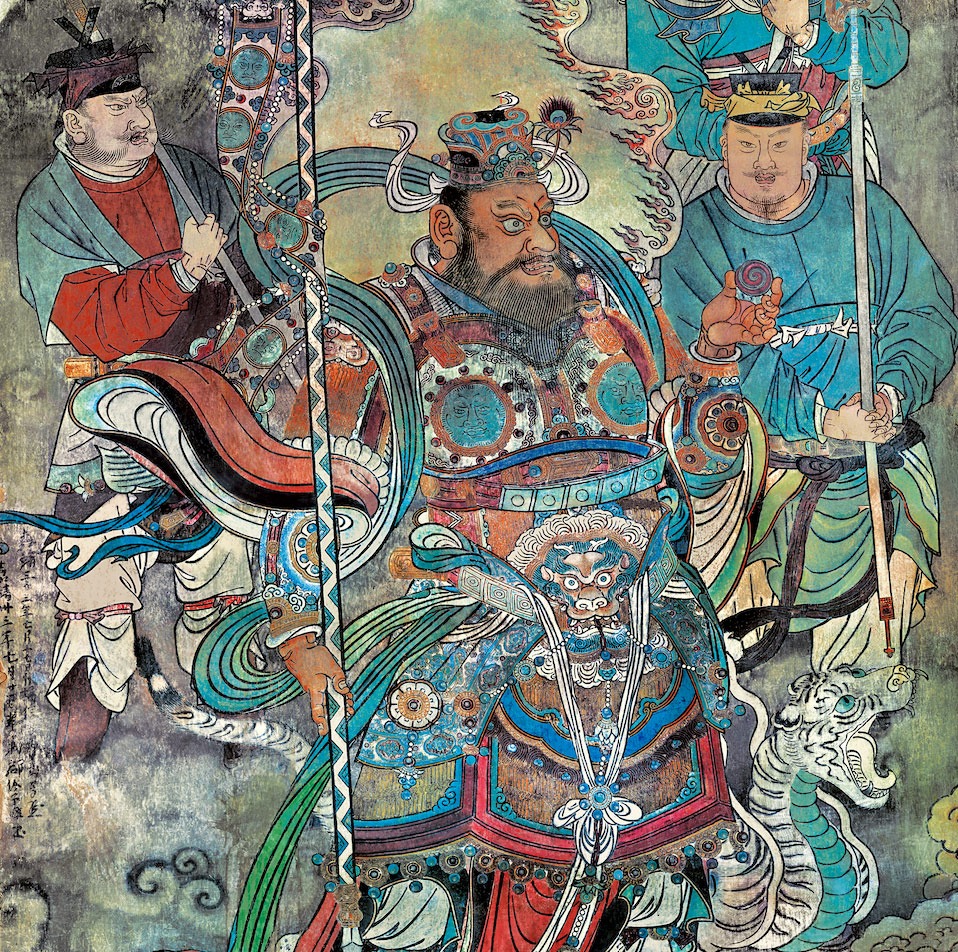




About the Artist
Artwork Story
The Assembly of the Divine (朝元图 Chao Yuan Tu), housed in the Sanqing Hall of Yongle Palace in Shanxi Province, China, is a monumental Daoist mural cycle completed in 1325 during the Yuan Dynasty (1271–1368). Commissioned by the Quanzhen Daoist sect to honor Lü Dongbin, one of the Eight Immortals, this work emerged during a period of cultural synthesis under Mongol rule, blending Han Chinese artistic traditions with influences from Central Asia and Tibetan Buddhism. The palace itself was relocated in 1959 to avoid submersion by the Three Gorges Dam project, a feat of modern conservation that preserved its 800+ square meters of murals.

The mural depicts 286 deities—including celestial emperors, star gods, military generals, and jade maidens—gathered to pay homage to the Three Pure Ones (the highest Daoist deities: Yuanshi Tianzun, Lingbao Tianzun, and Daode Tianzun). This scene embodies the Daoist cosmology of harmony between heaven, earth, and humanity, reflecting the Yuan rulers’ pragmatic embrace of multiple religions to consolidate power.
Artistic Brilliance: A Fusion of Line, Color, and Symbolism
- Composition and Scale
Spanning 94.68 meters in length and 4.26 meters in height, the mural’s grandeur rivals the Sistine Chapel frescoes. Eight principal deities (e.g., the Jade Emperor, Queen Mother of the West) dominate the composition, each towering at 3 meters tall, while smaller figures—arranged symmetrically in hierarchical rows—create a rhythmic flow of divine procession. The meticulous grouping of deities (e.g., the 28 Lunar Mansions, 12 Earthly Branches) reflects a sophisticated interplay of Daoist astrology and imperial bureaucracy. - Linework: The “Iron Wire” Technique
The mural’s defining feature is its “iron wire” brushwork (莼菜条), a legacy of Tang Dynasty master Wu Daozi. Lines stretch up to 3 meters without breaks, capturing the ethereal movement of robes and ribbons. For example, the flowing scarves of the South Pole Longevity Emperor demonstrate a seamless unity of precision and dynamism, earning it the title of “the pinnacle of Chinese linear art”. - Color and Material Splendor
Dominated by mineral pigments like malachite green and azurite blue, the palette symbolizes cosmic order. Gold leaf and raised gilding (沥粉贴金) adorn crowns, jewelry, and ritual objects, creating a divine luminosity. Notably, the use of Persian-inspired low-fired glazed ceramics in architectural elements (e.g., the dragon-fish roof finials) reveals Mongol-era cross-cultural exchanges. - Humanized Divinity
Unlike the rigid icons of medieval Christian art, the deities here exhibit lifelike expressions: the Queen Mother of the West radiates maternal serenity, while Thunder Gods grimace with ferocity. Even minor figures, like the Jade Maidens holding incense burners, are individualized through subtle gestures and attire.
The mural synthesizes Tang-Song painting techniques with Yuan innovations, serving as a critical link in China’s art history. Its compositional structure echoes the Tang-era Admonitions Scroll but amplifies narrative complexity, influencing later Ming-Qing religious art.
· With敦煌 (Dunhuang): While Dunhuang’s Buddhist murals emphasize spiritual transcendence, The Assembly of the Divine celebrates worldly hierarchy, mirroring Yuan sociopolitical realities.
· With Renaissance Frescoes: Like Giotto’s Scrovegni Chapel, it merges sacred narrative with human emotion, yet its collective focus contrasts with Western individualism.
Praised by art historian Lin Yutang as “the Daoist counterpart to the Last Supper,” the mural has inspired contemporary works, such as the costume designs in the film Creation of the Gods (2023), which drew directly from its iconography.
Why It Matters Today
The Assembly of the Divine is not merely a religious artifact but a universal testament to artistic ambition. Its survival through wars, floods, and political upheavals underscores humanity’s enduring need to visualize the sacred. For Western audiences, it offers a gateway to understanding:
· Daoist philosophy’s harmony with nature,
· The Mongol Empire’s role as a cultural mediator,
· China’s contribution to global mural traditions.
As the art critic Wang Bonin noted, “This mural’s true value lies in its power to transcend time—a celestial parliament that speaks equally to the 14th-century pilgrim and the 21st-century viewer”.


 (c. 1380-1390)-full.webp)
-full.webp)
-full.webp)
-full.webp)
-full.webp)
-full.webp)